Welwitschia mirabilis
Welwitschia mirabilis Hook.f. (= W. bainesii (Hook.f.) Carr.)
Family: Welwitschiaceae
Common names: welwitschia (Eng.), tumboa, n'tumbo (Angolan), tweeblaarkanniedood (Afr.), !kharos (Nama/Damara), nyanka (Damara), khurub (Nama), onyanga (Herero)
Introduction
Weird, peculiar, wonderful, strange, bizarre, fascinating, and of course, unique, are the kind of words that are used to describe the welwitschia. It is one of the few things on Earth that can truly claim to be one of a kind. There really is nothing like it.

Description
Description
An adult welwitschia consists of two leaves, a stem base and roots.That is all! Its two permanent leaves are unique in the plant kingdom.They are the original leaves from when the plant was a seedling, and they just continue to grow and are never shed. They are leathery, broad, strap-shaped and they lie on the ground becoming torn to ribbons and tattered with age. The stem is low, woody, hollowed-out, obconical in shape and sturdy. It grows to about 500 mm in height. The largest recorded specimen is in the Messum Mountains and is 1.8 m high, and another on the Welwitschia Flats near the Swakop River is 1.2 m tall and 8.7 m wide. Carbon dating tells us that on average, welwitschias are 500-600 years old, although some of the larger specimens are thought to be 2000 years old. Their estimated lifespan is 400 to 1500 years. Growth occurs annually during the summer months.
The sexes are separate, i.e. there are male plants and female plants. The male cones are salmon-coloured, small, oblong cone-like structures, and the female cones are blue-green, larger and more tapering. At Kirstenbosch, they flower from mid summer to autumn. The male flower has a sterile, modified pistil-like structure, which exudes nectar (50% sugar content) from a modified stigma-like structure. The female cone has exposed stigmas and also produces a nectar droplet.

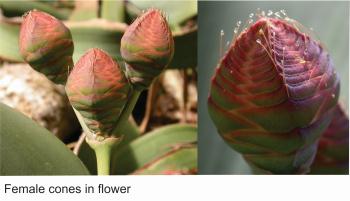
Cone-bearing plants are often wind pollinated, producing masses of pollen and all at the same time. Welwitschia is clearly not wind pollinated, as it produces smaller amounts of pollen, with the nectar to attract insects, and the flowers open in succession over an extended period, which also encourages cross-pollination. It may be a beetle, but judging by the fact that large distances can separate plants, Ernst van Jaarsveld thinks it is more likely to be a kind of wasp, which he has seen on the male cones in habitat. The female cones reach maturity in the spring, about 9 months after fertilization.
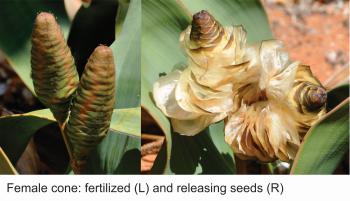
The seeds are 36 x 25 mm and have a large papery wing and are dispersed by wind, in spring, when the female cone disintegrates. In their natural habitat, many seeds are lost to fungal infection and to small desert animals that feed on them. The seeds remain viable for a number of years. They germinate only if fairly heavy rain is spread over a period of several days. As these conditions rarely occur, it often happens that many plants in some colonies are the same age, as they all germinated in the same good year. The seedlings, once established, depend on the fog for survival until the next rains occur.
There are more remarkable features that make Welwitschia so difficult to categorise: Unlike any other plant, the apical growth point of the stem stops growing from an early stage. This causes the stem to grow upwards and outwards, away from the original apex (which remains dead), resulting in the characteristic obconical shape. In older specimens, continued growth results in the undulating of the stem margin. This growth habit is unique. Like other cone-bearing plants (gymnosperms e.g. pines and cycads) it is a dioecious (male and female separate) cone-bearer with naked seeds, but the male 'flowers' or microstroboli are reminiscent of the flowering plants (angiosperms). The water-conducting tissue (xylem) is also typical of the angiosperms.
Conservation Status
Status
Welwitschia has not been assessed by the IUCN Red List. It is still common in its habitat and shows variability, which is a sign that it is far from extinction. They are neither endangered nor rare, nevertheless they are protected by law.
Distribution and habitat
Distribution description
Welwitschia mirabilis grows in isolated communities in the Namib Desert, in a narrow strip, about 1 000 km along up the coast from the Kuiseb River in central Namibia to Mossamedes in southern Angola. The plants are seldom found more than 100 to 150 km from the coast, and their distribution coincides with the fog belt.
Derivation of name and historical aspects
History
Welwitschia mirabilis was discovered by the Austrian botanist,explorer and medical doctor, Friedrich Welwitsch, in 1859 in the Namib Desert of southern Angola. The story goes that he was so overcome by his find that he knelt down next to it and simply stared. Thomas Baines, the renowned artist and traveller, also found a plant in the dry bed of the Swakop River in Namibia in 1861. Welwitsch sent the first material of Welwitschia to Sir Joseph Dalton Hooker, Director of Kew, in 1862. Hooker described it and named it in honour of Welwitsch, despite the fact that Welwitsch recommended that it be named Tumboa, its native Angolan name. Its species name mirabilis means marvellous or wonderful in Latin. The specific name was later changed to bainesii to honour both men involved in its discovery, but by the rules of botanical nomenclature, mirabilis is the current and valid name.
Because it is so different from other gymnosperms, Welwitschia was placed in its own family in a small order of gymnosperms called the Gnetales. It shares this order with two other families each containing one genus: the Gnetaceae (Gnetum, 30 species) and the Ephedraceae (Ephedra, 40 species). All three genera can stand by themselves, and the relationships between them are remote. There is nothing else like them, and of the three, Welwitschia is the most remote.
Welwitschia is thought to be a relic from the Jurassic period when gymnosperms dominated the world's flora, its ancestor trapped in an environment that slowly but progressively became more arid, and all its close relatives long since disappeared.

Ecology
Ecology
Welwitschia is ecologically highly specialized, and is adapted to grow under arid conditions receiving regular fog. This regular, dense fog is formed when the cold north-flowing Benguela Current meets the hot air coming off the Namib Desert. The fog develops during the night and usually subsides by about 10 a.m. The leaves are broad and large and droop downwards. This is an ideal way for it to water its own roots from water collected by condensation. It also has numerous stomata on both leaf surfaces and it was thought that fog-water was taken up directly through these stomata but this has been shown not to be true. The fog has been estimated to contribute 50 mm in annual rainfall, but in spite of the fog, the plants are still dependent on additional sources. Rainfall in this area is erratic and extremely low, only 10-100 mm during the summer months. In some years, no rain falls at all. The plants are often confined to dry watercourses or next to higher rainfall regions, and they occasionally grow on rocky outcrops. All these habitats point to an additional underground water supply. The plant has a long taproot, allowing it to reach this underground water.
There are other interesting environmental adaptations. The largest plants are found to the south where the rainfall is the least, whereas in the north where the rainfall is higher the plants are much smaller. The most likely reason for this is that the plants in the north have to compete with savanna vegetation whereas those in the south have little or no competition. Another interesting adaptation is the corky bark, which could be the result of thousands of years of exposure to grass fires so commonly associated with savanna.
Antelope and rhino chew the leaves for their juice during times of drought, and spit out the tough fibres. They also eat the soft part near the groove. This luckily does not damage the plant as they simply grow out again from the meristematic tissue.
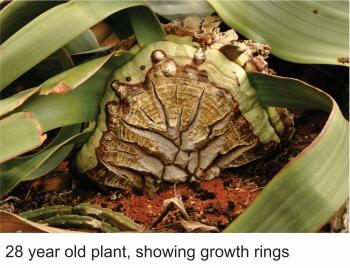
Uses
Use
The core, especially of the female plant, was used as food for people in earlier times. It is said to be very tasty either raw or baked in hot ashes, and this is how it got its Herero name, onyanga, which means onion of the desert.
Growing Welwitschia mirabilis
Grow
Welwitschia is not a true succulent, yet it is the succulent growers and enthusiasts that are most interested in it. It is caudiciform, yet is not often included in accounts of these plants as it belongs in the 'wrong' family. Tree enthusiasts regard it as a tree driven underground. Ernst van Jaarsveld, who looked after the succulents at Kirstenbosch from 1976 until 2015 and who has been successfully cultivating welwitschias in this time, regards Welwitschia as a terminally truncated caudiciform, although initially semi-succulent, woody xerophyte. To cultivate Welwitschia successfully, he recommends that its peculiar native environment be simulated.
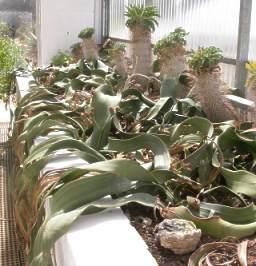
At Kirstenbosch, a Welwitschia House was custom-built in 1985 in the Collections Nursery, containing raised beds with bottom heating, filled with mineral-rich, well-drained, red "Vanrhynsdorp sand". Seeds were sown in1985 and one of the young plants flowered exactly two years and six months later. This was a new record, and Ernst attributes their success to the bottom heating during winter, the sand, and the regular watering. This house was not open to the public, but in 2009 one of the corner units in the Conservatory was adapted to accommodate Welwitschias. Seeds were sown in 2009 and the new Welwitschia House was opened to the public in 2013.
At first glance it would appear that Welwitschia would be almost impossible to grow, but this is only partly true. Welwitschias can be grown easily, even as pot plants and even on window sills and verandahs in cooler climates. Once established, the plant will grow steadily and is relatively disease free. The most crucial stage is during its first eight months after germination when it is prone to fungal attack. Also, as it is not a true succulent, it should not be treated as one. It is dependant on additional water from its roots and if grown in a pot, care should be taken that the soil does not dry out completely.
When growing welwitschia there are a few important factors to take into consideration: the long taproot, its dependence on extra moisture and the soil used. Plants from arid regions are often lost to fungal infection caused by soil with a high organic content. It is safer to use a sandy mixture, water more frequently and give supplementary feedings. It is also recommended to use sterilized soil. Older plants tend to accumulate organic debris around themselves which enriches the soil and acts as a mulch, helping to retain water in the upperlayers of the sand for longer.
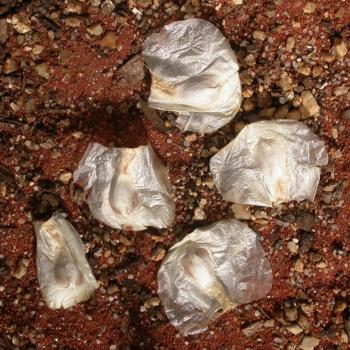
Seeds should be sown in the warmer months, spring or summer. In habitat the seeds are dispersed in spring, but have to wait for rain to fall before they germinate. It is best to sow seeds into a large, deep (at least 300 mm, preferably more) container or into an open bed where the plant is intended to remain, because the taproot grows quite fast in the initial stages. If using a container, remember to place a layer of gravel or rocks at the bottom to ensure good drainage. The soil must be sandy and well-drained, e.g. 2 parts sand : 1 part loam : 1 part compost (leaf mould) with ample bonemeal, well mixed and sterilized. Moisten the soil thoroughly before sowing. If using a container, sow two or three seeds per container, near the centre. If more than one germinates, it can be transplanted in its first month, or left to form interesting graft complexes with its sibling. If you have an open bed, scatter them evenly over the surface. Place the seeds on top of the soil and just cover them with a layer of sand. Water well and keep in a warm sunny situation. It is important to add a mild fungicide, like Captan, to the water during the first year as it will prevent fungal attack. Keep the soil moist until the seeds have germinated. Germination takes 1 to 3 weeks.
The placement of the ungerminated and germinating seedlings is also important. Choose a well-aerated, warm atmosphere, preferably in filtered sunlight. The plants are very sensitive to sudden changes in light intensity. Never move a plant from a shady situation to full sun, the leaves will burn and the plant may never recover and die. So when moving your plant, make sure that you gradually harden it off to brighter light. Welwitschias in containers can be grown in glasshouses, window sills, verandahs or outdoors in areas with rainfall of below 500 mm per annum. In higher rainfall areas, it may be quite happy on a slope. Also, we do not know its frost tolerance. Just because its habitat is frost-free today, does not mean that it did not have to contend with a colder climate during its evolutionary history.
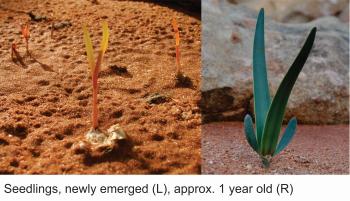
Germination should occur from 7 days to a few months after sowing.The first sign is the cracking of the soil and the appearance ofthe two cotyledons, initially pink in colour, becoming green. Initial growth is very rapid, particularly the growth of the taproot. It is essential that seedlings in a shallow tray be planted out as soon as the cotyledons appear. Take care when transplanting, if the root tip is damaged or broken, the seedling will die. Keep the seedlings well watered during the first season. The warmer the temperature, the faster they will grow. At Kirstenbosch, the temperature in the Welwitschia House varies between 20 and 40 degrees C in summer and growth is good, 20-30 mm high in three weeks with a taproot 50-70 mm long. It is better to give too much water than too little, but remember the fungicide.
Seedlings should be watered regularly, at least once a week at first, and later watering can be reduced to once every two weeks.The amount of water also depends on the climate, cooler climates requiring less watering than hot dry ones. During the natural resting period in winter, watering should be reduced, and increased in late spring when the weather warms up again.
Welwitschia reacts well to being fed, and 'greens up' and grows a bit more rapidly in response to a mild, natural, organic seaweed-based fertilizer added to the water once every three months during the summer. The Kirstenbosch plants also get a dose of inorganic 2:3:4 in the spring.
The cotyledons may last for up to two years in cultivation. They become erect and expand to a length of 27-35 mm and the permanent leaves will then become visible between them. They are always opposite to the cotyledons and it is these two leaves that the plant retains for life. The permanent leaves grow rapidly, soon overtaking the cotyledons. They are upright at first, becoming erectly spreading after 8-12 weeks and eventually diverging. Between the two leaves another pair of what appear to be leaves will appear. These are the cotyledonary buds, also situated opposite the cotyledons. They gradually become swollen and keeled and from here onwards, the peculiar growth habit begins. These cotyledonary buds are in fact axillary buds whose apical growth stops, causing the death of the growing tip. Now, instead of apical growth the buds gradually broaden, eventually merging. The meristematic tissue at the base of the buds now grows sideways, together with the meristematic tissue on the outer sides of the leaf, which causes the leaf groove to deepen and causes the characteristic obconical growth of the stem apex. This growth occurs annually during the warmer months and is visible in concentric rings. Thus age can be roughly estimated by counting these rings, analogous to the growth rings of a tree.
Welwitschia is relatively disease-free, except during its first year or so when it should be watered with a fungicide. They are prone to attack by woolly aphid, but this can be controlled with an insecticide like Malasol. Caterpillars have also been caught on the leaves of the Kirstenbosch plants.
References
- VAN JAARSVELD, E. 1990. The cultivation and care of Welwitschia mirabilis: the extraordinary caudiciform from the Namib Desert. Aloe 27; 69-82.
- VAN JAARSVELD, E. 2000. Welwitschia mirabilis. Veld & Flora 86: 176-179.
- VAN JAARSVELD, E. 1992. Welwitschia mirabilis in cultivation at Kirstenbosch. Veld & Flora 78: 118-120.
- CRAVEN, P. & MARAIS, C. 1992. Damaraland Flora. Gamsberg, Macmillan, Windhoek, Namibia.
- CRAVEN, P. & MARAIS, C. 1986. Namib Flora. Gamsberg, Macmillan, Windhoek, Namibia.
Credits
Alice Notten
Kirstenbosch National Botanical Garden
March 2003, updated June 2016
Plant Attributes:
Plant Type: Shrub, Succulent
SA Distribution:
Soil type: Sandy
Flowering season:
PH:
Flower colour:
Aspect: Full Sun
Gardening skill: Challenging
Special Features:
Horticultural zones






Rate this article
Article well written and informative
Rate this plant
Is this an interesting plant?
Login to add your Comment
Back to topNot registered yet? Click here to register.